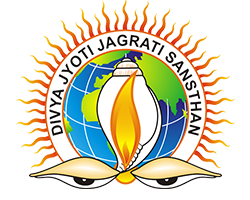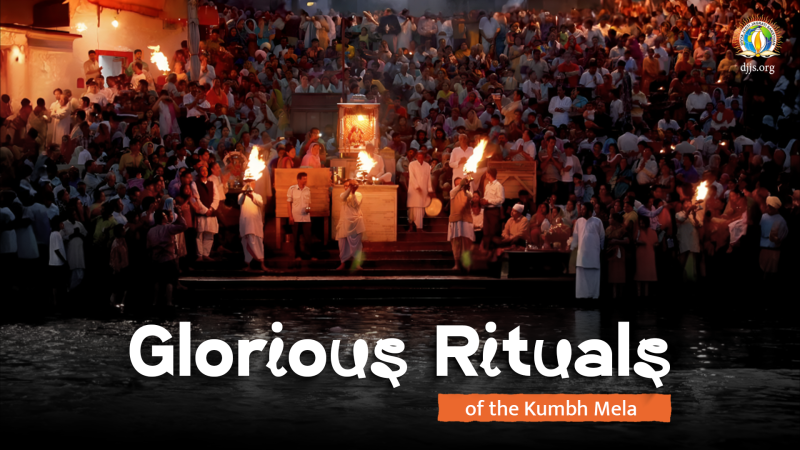The biggest spiritual gathering on the planet—Mahakumbh Mela 2025—is currently taking place in Prayagraj, Uttar Pradesh. The festival showcases the beauty and divinity of Sanatan Dharma through its various glorious rituals, which, when decoded by the grace of a Shrotriya Brahmanishtha Guru [Self-realized, Knower of Brahman, the Perfect Spiritual Master], can help one realize the true purpose of life. Let’s delve into the deep spiritual significance of these sacred traditions.
A Sacred Dip in Triveni
Taking a sacred dip at Triveni Sangam (the confluence of the Ganga, Yamuna, and Saraswati Rivers) is believed to liberate individuals from past karmas.
Spiritual Significance – The outer Triveni Sangam symbolizes the inner confluence of Ida (Left Channel), Pingala (Right Channel), and Sushumna (Central Channel), which converge at the Ajna Chakra (located at the center of the forehead). A Perfect Spiritual Master (Guru) activates the Sushumna (third eye), enabling the seeker to experience God within. The Satguru (Perfect Spiritual Master) unveils the Divine within, and meditating upon the Divine liberates one from the effects of past karmas, leading to salvation.
Aarti & Yajnas
Vedic chanting, daily pujans, and yajnas at Kumbh fill the atmosphere with devotion. Saints and devotees alike participate in these sacred rituals, performed to purify the environment and elevate collective consciousness. The purpose is to pray for the well-being of all humanity.
Spiritual Significance – The samidha (wood offerings) in the havan symbolizes the sacrifices individuals make for society, transcending personal desires and attachments (raag and dvesh) to work towards the spiritual upliftment of humanity. However, true selflessness can only be realized when one is connected with God, as without this spiritual connection, genuine selflessness remains unattainable.
Deep Daan
A practice of lighting oil lamps (diyas) across temples, streets, rivers, hermitages, and other sacred sites at Kumbh, this devotion-filled tradition spreads positivity, joy, and divine celebration. These diyas symbolize prayers at the lotus feet of the Almighty, seeking the dispelling of ignorance and the illumination of knowledge in every being.
Spiritual Significance – God’s Tattvaroop (Elemental Form) is Divine Light. In the Bhagavad Gita, Lord Krishna proclaims:
"ज्योतिषामपि तज्ज्योतिस्तमसः" – "I am the Light of all lights, shining beyond all darkness."
The lighting of diyas signifies the awakening of this Divine Light within—direct perception of God—and rising above the darkness of ignorance.
Visiting Temples
It is believed that Lord Brahma himself established the Dwadasa Madhav (Twelve Madhav) Temples, dedicated to Lord Krishna, along the riverbanks. In the Treta Yuga, Maharishi Bhardwaj guided devotees in circumambulating (parikrama) these temples for spiritual upliftment. Additionally, seekers visit various Shaktipeethas, as well as temples of Lord Shiva, Ganesha, and Hanuman.
Spiritual Significance – In the Skanda Purana, Guru Gita, Lord Shiva states:
"अन्तःस्थ सच्चिदानंद साक्षात्कारं" – "God resides within every being (in every atom of creation) and can be perceived internally with the grace of the Perfect Master."*
Thus, the human body itself is the living temple of Ishvara (God). External temples serve as reminders, inspiring us to seek divine knowledge within.
Spiritual Discussions with Saints
The eternal human quest—Who am I?—drives many seekers to Kumbh. This sacred gathering is graced by the presence of Perfect Masters (Gurus) and enlightened saints, offering a rare opportunity for spiritual seekers to engage in profound discussions and receive divine wisdom.
Spiritual Significance – Sage Yajnavalkya explains to Maitreyi in the Brihadaranyaka Upanishad:
"आत्मा वा अरे श्रोतव्यो मन्तव्यो द्रष्टव्यः निदिध्यासितव्यः"
"The ‘Atma’ (Soul) alone is worth listening to, contemplating, seeing, and meditating upon."
Thus, all spiritual inquiries—especially the question "Who am I?"—ultimately seek the realization of the Soul or God within, a revelation granted by the grace of the Guru (the Perfect Master of the time).
Kalpavas
According to the Padma Purana, a Kalpvasi must observe 21 rules through mind, speech, and action, including self-discipline, attending spiritual discourses, engaging in charity, and practicing meditation.
Spiritual Significance – Kalpa means the entire cycle of creation, while vas means to reside within it. Thus, Kalpavas signifies connecting with the all-pervading Supreme Consciousness (God), who exists both within and beyond creation. By mastering self-discipline, meditation, charity, and spiritual discourses, this divine connection becomes a living experience.
Meditation, Bhakti & Yoga and Their Spiritual Significance
The Kumbh Mela is infused with bhajan-sankirtans, where devotees come together to sing hymns in praise of the Lord, sometimes even while walking through the streets of Prayagraj. Through spiritual discourses by saints and sannyasis, the Kumbh Mela offers an infinite wealth of wisdom and devotion. Seekers gather here to practice meditation (sadhana), but Divya Guru Shri Ashutosh Maharaj ji states true meditation is not merely the closure of the outer eyes but opening of the third eye.
Third eye symbolizes the confluence of the three sacred rivers. A dip in this inner confluence redeems one from past samskaras, fulfilling the essence of Yoga.
The Yoga Sutras of Patanjali define yoga as:
"योगश्चित्तवृत्ति निरोधः" – "Yoga is the cessation of the fluctuations of the mind."
This underscores the ultimate goal of yoga: to quiet the mind and attain inner peace and self-realization. However, this state can only be achieved under the guidance of a Perfect Spiritual Master, who activates the inner Sangam, leading the seeker to direct God-realization.
Join Us for the 5-Dimensional Maha Kumbh Celebration!
To experience these profound spiritual insights and the true essence of Kumbh—both outwardly and inwardly—join us for the 5-dimensional Maha Kumbh celebration in Prayagraj.
Visit DJJS Campsite – Gangeshwar Bajrangdas Chauraha, Sec-9, Near Amitabh Puliya, Govindpur, Prayagraj
For more information, visit – djjs.org/kumbh

